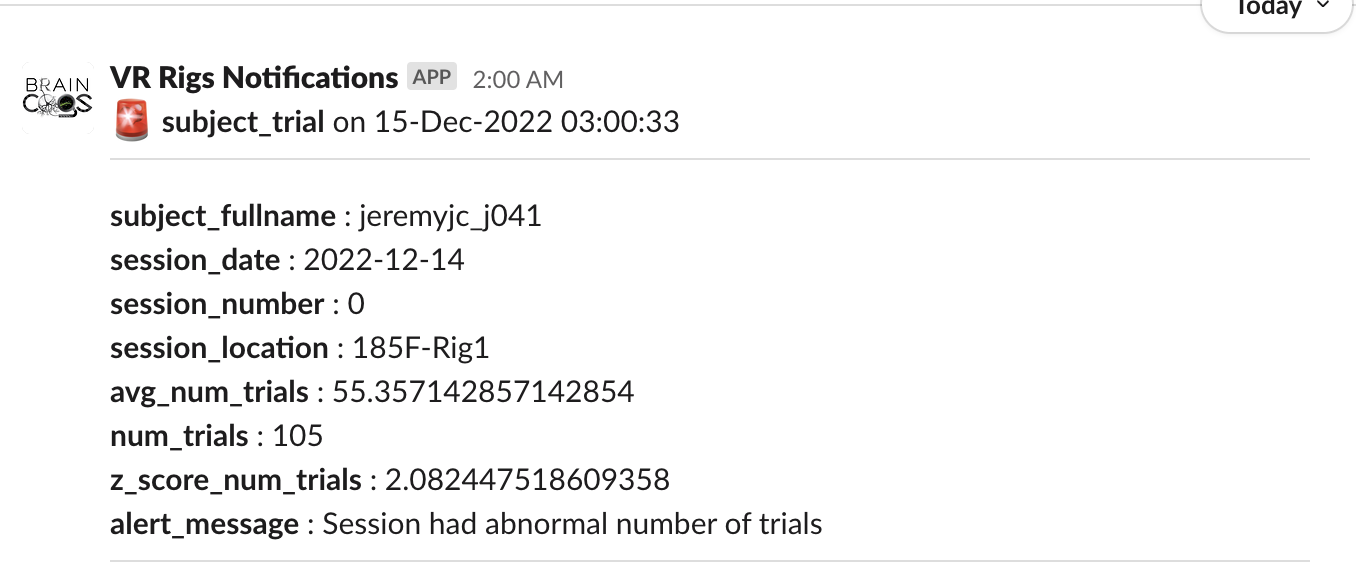Configure custom slack alerts
Set up custom slack alerts
- Follow Database Access with Python instructions
- On U19_pipeline_python repository open
u19_pipeline/alert_system/custom_alerts directory - Create a new python file with a meaningful name for the alert: (e.g.
subject_bias.py) - Copy skeleton code from
u19_pipeline/alert_system/alert_code_skeleton.py
- All slack alert code has two parts: a slack channel configuration and a main function described on the next section:
main function guide
- This function should return a pandas DataFrame where each row will be a slack alert message on configured channels.
- You can use datajoint to get data for the alert (e.g. custom_alerts/rig_bias.py) or simply call os scripts (e.g. custom_alerts/braininit_storage.py)
- All columns of the dataframe will be included in the alert. (Don't add too many !!)
- Dataframe Example with slack notification message:


- You can check examples of some alers in the u19_pipeline/alert_system/custom_alerts directory
Slack channel dictionary configuration
The slack channel configuration is a dictionary to link corresponding slack channels and conversations with an specific alert.
The dictionary has two keys:
'slack_notification_channel'and'slack_users_channel'slack_notification_channel General channels names to send notifications.
slack_users_channel Private direct message to send notificatons.
You can add a list of channels to each of the keys:
slack_notification_channel Any
webhook_name(see next section)slack_users_channel Any user_id with configured slack_weebhook (see next section)
Check available notification channels:
MATLAB
- Execute
fetch(lab.SlackWebhooks,'*')
Python
- Execute:
lab = dj.create_virtual_module('lab', 'u19_lab')lab.SlackWebhooks.fetch(as_dict=True)
Check available user channels:
MATLAB
- Execute
fetch(lab.User & "slack_webhook <> ''",'slack_webhook')
Python
- Execute:
lab = dj.create_virtual_module('lab', 'u19_lab')(lab.User & "slack_webhook <> ''").fetch('KEY', 'slack_webhook', as_dict=True)
Create and register new webhooks for alerts:
- Create a new slack channel if needed (for notification channels).
- Follow instructions to create webhooks from: Slack documentation
- Copy slack webhook from slack API web page.
Add notification channels:
MATLAB
new_slack_webhook = struct
new_slack_webhook.webhook_name = (notification channel name)
new_slack_webhook.webhook_url = (webhook url from slack API)
insert(lab.SlackWebhooks,new_slack_webhook)
Python
lab = dj.create_virtual_module('lab', 'u19_lab')
new_slack_webhook = dict()
new_slack_webhook['webhook_name'] = (notification channel name)
new_slack_webhook['webhook_url'] = (webhook url from slack API)
lab.SlackWebhooks.insert1(new_slack_webhook)
Update user channel webhook notification channels:
MATLAB
user = struct
user.user_id = (NETID of user)
update(lab.User & user,'slack_webhook', (webhook url from slack API))
Python
lab = dj.create_virtual_module('lab', 'u19_lab')
user = dict()
user['user_id'] = (NETID of user)
user['slack_webhook'] = (webhook url from slack API)
lab.User.update1(user)